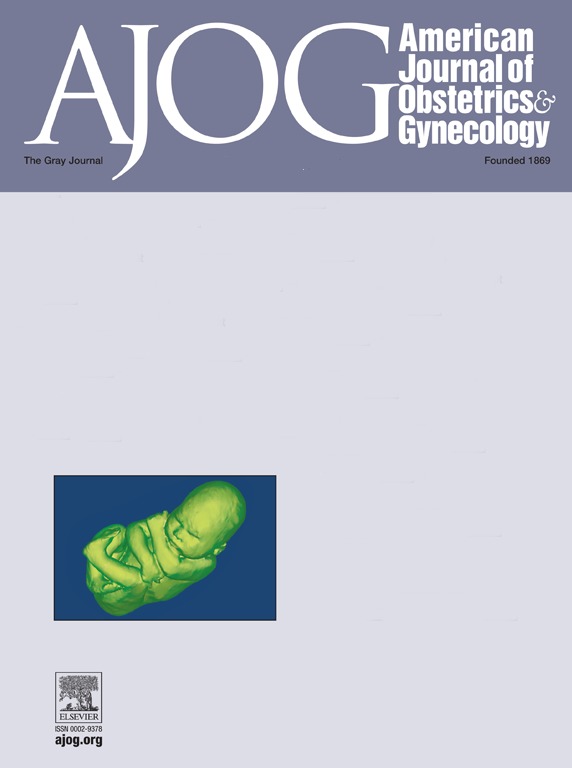胎儿积液谱系的遗传疾病。
IF 8.7
1区 医学
Q1 OBSTETRICS & GYNECOLOGY
引用次数: 0
摘要
非免疫性积水胎儿(NIHF)是异质的,是许多遗传疾病的常见终点。然而,对其他类型胎儿积液(如单次积液)的遗传疾病的患病率和表现特征知之甚少,这在临床实践中对这些妊娠的最佳检测和咨询方法留下了不确定性。我们的目的是通过胎儿积液类型和并发结构异常的存在来确定外显子组测序(ES)的诊断率,并确定潜在遗传疾病的独特表现特征。方法:我们进行了一项关于NIHF和其他胎儿积液孕妇的前瞻性队列研究,参与者来自美国各地。纳入标准为染色体微阵列和/或核型的非诊断性结果以及至少一种胎儿积液的存在,包括NT≥3.5 mm、囊性水肿、胸腔积液、心包积液、腹水和/或皮肤水肿。ES由我们机构的clia认可的实验室进行,结果返回给参与者及其提供者。详细的胎儿表型数据被确定并用于遗传变异解释,包括胎儿成像结果(超声、MRI、超声心动图)、病理报告和实验室报告。妊娠有一个或多个被归类为致病或可能致病的变异被认为是诊断性的或阳性的。主要结局是胎儿积液类型ES的诊断率,有无并发结构异常。次要结局是按遗传疾病类别观察胎儿积液的类型。结果118例合并NIHF及其他积液的孕妇行ES检查,其中23%(27/118)诊断阳性。伴有或不伴有结构异常的NIHF妊娠的诊断率分别为21%(9/42)和40% (6/15)(p=0.15)。单一积液如胸腔积液合并或不合并结构异常的诊断率分别为23%(6/26)和17% (1/6)(p=0.61)。合并结构异常的妊娠NT或囊性水肿的诊断率(42%,5/12)明显高于未合并结构异常的妊娠(0%,0/17,p<0.01)。我们进一步观察了遗传疾病如何在子宫内出现的许多模式,如rasopathy和肌肉骨骼疾病表现出所有类型的积液,而其他以出生后神经发育迟缓为标志的疾病表现出除了NIHF以外的所有类型的积液。结论ES的诊断率在所有类型的积液中都很高,包括伴有或不伴有结构异常的单一积液,除了孤立的颈部透明度增加或囊性水瘤。此外,我们观察到许多模式的遗传疾病如何出现在子宫与胎儿积液。这些发现为咨询和临床管理提供了重要信息,突出了ES在NIHF以外胎儿积液中的应用,并为表型驱动测试(如ES)提供了准确的结果。本文章由计算机程序翻译,如有差异,请以英文原文为准。
Genetic diseases underlying a spectrum of fetal effusions.
INTRODUCTION
Non-immune hydrops fetalis (NIHF) is well understood to be heterogenous and the common endpoint of many genetic diseases. However, less is known about the prevalence and presenting features of genetic diseases that underlie other types of fetal effusions such as single effusions, leaving uncertainty in clinical practice about optimal approaches to testing and counseling for these pregnancies. We aimed to determine the diagnostic yield of exome sequencing (ES) by type of fetal effusion and presence of concurrent structural abnormalities, as well as to identify the unique presenting features of underlying genetic diseases.
METHODS
We conducted a prospective cohort study of pregnancies with NIHF and other fetal effusions, with participants enrolled from across the United States. Inclusion criteria were non-diagnostic results of chromosomal microarray and/or karyotype and the presence of at least one fetal effusion, including NT ≥3.5 mm, cystic hygroma, pleural effusion, pericardial effusion, ascites, and/or skin edema. ES was performed by our institution's CLIA-approved laboratory and results were returned to participants and their providers. Detailed fetal phenotypic data were ascertained and used to inform genetic variant interpretation, including fetal imaging findings (ultrasound, MRI, echocardiogram), pathology reports, and laboratory reports. Pregnancies with a variant or variants classified as pathogenic or likely pathogenic were considered diagnostic or positive. The primary outcome was the diagnostic yield of ES by type of fetal effusion, with and without concurrent structural abnormalities. Secondary outcomes were the types of fetal effusions observed by category of genetic disease.
RESULTS
In all, 118 pregnancies with NIHF and other effusions underwent ES and 23% (27/118) had positive (diagnostic) findings. Pregnancies with NIHF with and without concurrent structural abnormalities had diagnostic yields of 21% (9/42) and 40% (6/15), respectively (p=0.15). Single effusions such as pleural effusion with and without concurrent structural abnormalities had diagnostic yields of 23% (6/26) and 17% (1/6), respectively (p=0.61). The diagnostic yield for increased NT or cystic hygroma was significantly greater for pregnancies with concurrent structural abnormalities (42%, 5/12) compared to those without (0%, 0/17, p<0.01). We further observed numerous patterns in terms of how genetic diseases present in utero, such as RASopathies and musculoskeletal disorders demonstrating all types of effusions, while other disorders marked by neurodevelopmental delays after birth demonstrated all types of effusions except for NIHF.
CONCLUSIONS
The diagnostic yield of ES was high across all types of effusions including single effusions with and without concurrent structural abnormalities, with the exception of isolated increased nuchal translucency or cystic hygroma. Further, we observed numerous patterns in terms of how genetic diseases present in utero with fetal effusions. These findings contribute important information for counseling and clinical management, highlight the utility of ES for fetal effusions beyond NIHF, and inform accurate results of phenotype-driven tests such as ES.
求助全文
通过发布文献求助,成功后即可免费获取论文全文。
去求助
来源期刊
CiteScore
15.90
自引率
7.10%
发文量
2237
审稿时长
47 days
期刊介绍:
The American Journal of Obstetrics and Gynecology, known as "The Gray Journal," covers the entire spectrum of Obstetrics and Gynecology. It aims to publish original research (clinical and translational), reviews, opinions, video clips, podcasts, and interviews that contribute to understanding health and disease and have the potential to impact the practice of women's healthcare.
Focus Areas:
Diagnosis, Treatment, Prediction, and Prevention: The journal focuses on research related to the diagnosis, treatment, prediction, and prevention of obstetrical and gynecological disorders.
Biology of Reproduction: AJOG publishes work on the biology of reproduction, including studies on reproductive physiology and mechanisms of obstetrical and gynecological diseases.
Content Types:
Original Research: Clinical and translational research articles.
Reviews: Comprehensive reviews providing insights into various aspects of obstetrics and gynecology.
Opinions: Perspectives and opinions on important topics in the field.
Multimedia Content: Video clips, podcasts, and interviews.
Peer Review Process:
All submissions undergo a rigorous peer review process to ensure quality and relevance to the field of obstetrics and gynecology.

 求助内容:
求助内容: 应助结果提醒方式:
应助结果提醒方式:


